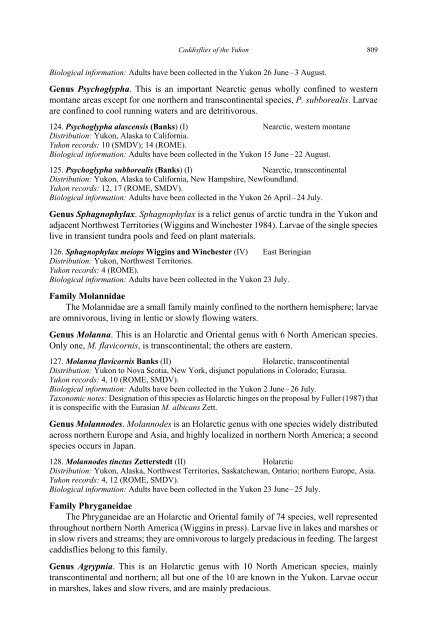Caddisflies of the Yukon - Department of Biological Sciences ...
Caddisflies of the Yukon - Department of Biological Sciences ...
Caddisflies of the Yukon - Department of Biological Sciences ...
Create successful ePaper yourself
Turn your PDF publications into a flip-book with our unique Google optimized e-Paper software.
<strong>Caddisflies</strong> <strong>of</strong> <strong>the</strong> <strong>Yukon</strong> 809<br />
<strong>Biological</strong> information: Adults have been collected in <strong>the</strong> <strong>Yukon</strong> 26 June – 3 August.<br />
Genus Psychoglypha. This is an important Nearctic genus wholly confined to western<br />
montane areas except for one nor<strong>the</strong>rn and transcontinental species, P. subborealis. Larvae<br />
are confined to cool running waters and are detritivorous.<br />
124. Psychoglypha alascensis (Banks) (I) Nearctic, western montane<br />
Distribution: <strong>Yukon</strong>, Alaska to California.<br />
<strong>Yukon</strong> records: 10 (SMDV); 14 (ROME).<br />
<strong>Biological</strong> information: Adults have been collected in <strong>the</strong> <strong>Yukon</strong> 15 June – 22 August.<br />
125. Psychoglypha subborealis (Banks) (I) Nearctic, transcontinental<br />
Distribution: <strong>Yukon</strong>, Alaska to California, New Hampshire, Newfoundland.<br />
<strong>Yukon</strong> records: 12, 17 (ROME, SMDV).<br />
<strong>Biological</strong> information: Adults have been collected in <strong>the</strong> <strong>Yukon</strong> 26 April – 24 July.<br />
Genus Sphagnophylax. Sphagnophylax is a relict genus <strong>of</strong> arctic tundra in <strong>the</strong> <strong>Yukon</strong> and<br />
adjacent Northwest Territories (Wiggins and Winchester 1984). Larvae <strong>of</strong> <strong>the</strong> single species<br />
live in transient tundra pools and feed on plant materials.<br />
126. Sphagnophylax meiops Wiggins and Winchester (IV) East Beringian<br />
Distribution: <strong>Yukon</strong>, Northwest Territories.<br />
<strong>Yukon</strong> records: 4 (ROME).<br />
<strong>Biological</strong> information: Adults have been collected in <strong>the</strong> <strong>Yukon</strong> 23 July.<br />
Family Molannidae<br />
The Molannidae are a small family mainly confined to <strong>the</strong> nor<strong>the</strong>rn hemisphere; larvae<br />
are omnivorous, living in lentic or slowly flowing waters.<br />
Genus Molanna. This is an Holarctic and Oriental genus with 6 North American species.<br />
Only one, M. flavicornis, is transcontinental; <strong>the</strong> o<strong>the</strong>rs are eastern.<br />
127. Molanna flavicornis Banks (II) Holarctic, transcontinental<br />
Distribution: <strong>Yukon</strong> to Nova Scotia, New York, disjunct populations in Colorado; Eurasia.<br />
<strong>Yukon</strong> records: 4, 10 (ROME, SMDV).<br />
<strong>Biological</strong> information: Adults have been collected in <strong>the</strong> <strong>Yukon</strong> 2 June – 26 July.<br />
Taxonomic notes: Designation <strong>of</strong> this species as Holarctic hinges on <strong>the</strong> proposal by Fuller (1987) that<br />
it is conspecific with <strong>the</strong> Eurasian M. albicans Zett.<br />
Genus Molannodes. Molannodes is an Holarctic genus with one species widely distributed<br />
across nor<strong>the</strong>rn Europe and Asia, and highly localized in nor<strong>the</strong>rn North America; a second<br />
species occurs in Japan.<br />
128. Molannodes tinctus Zetterstedt (II) Holarctic<br />
Distribution: <strong>Yukon</strong>, Alaska, Northwest Territories, Saskatchewan, Ontario; nor<strong>the</strong>rn Europe, Asia.<br />
<strong>Yukon</strong> records: 4, 12 (ROME, SMDV).<br />
<strong>Biological</strong> information: Adults have been collected in <strong>the</strong> <strong>Yukon</strong> 23 June – 25 July.<br />
Family Phryganeidae<br />
The Phryganeidae are an Holarctic and Oriental family <strong>of</strong> 74 species, well represented<br />
throughout nor<strong>the</strong>rn North America (Wiggins in press). Larvae live in lakes and marshes or<br />
in slow rivers and streams; <strong>the</strong>y are omnivorous to largely predacious in feeding. The largest<br />
caddisflies belong to this family.<br />
Genus Agrypnia. This is an Holarctic genus with 10 North American species, mainly<br />
transcontinental and nor<strong>the</strong>rn; all but one <strong>of</strong> <strong>the</strong> 10 are known in <strong>the</strong> <strong>Yukon</strong>. Larvae occur<br />
in marshes, lakes and slow rivers, and are mainly predacious.
















